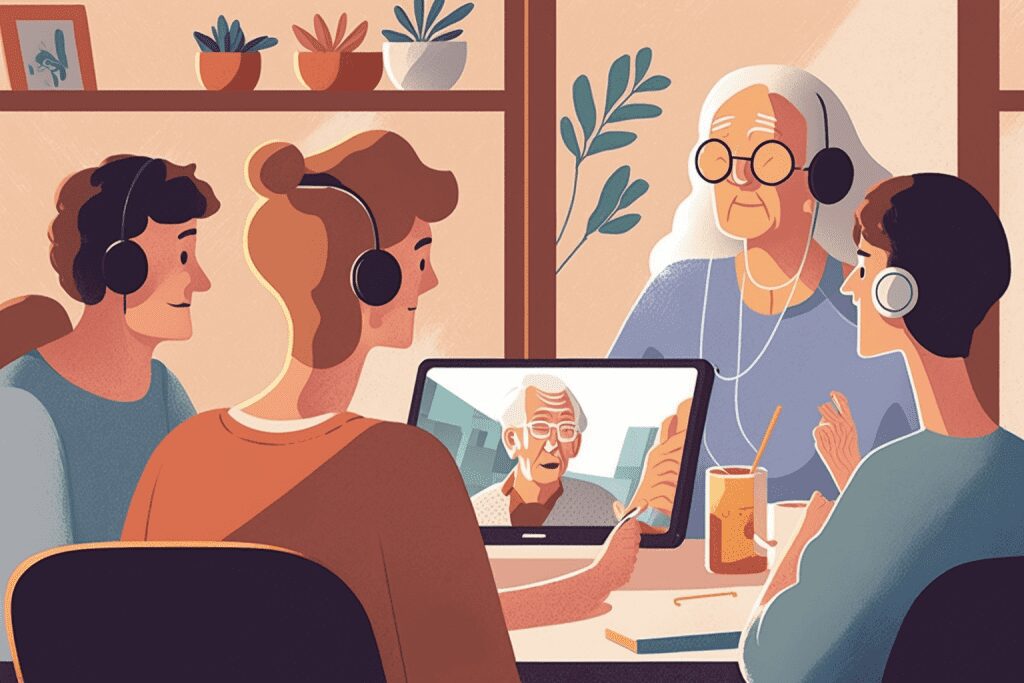AI-Driven assistive devices play a crucial role in the lives of older adults with vision and hearing loss, helping them maintain independence and enhancing their overall quality of life. Artificial intelligence (AI) has recently emerged as a game-changer in this field, bringing a new level of sophistication and effectiveness to accessibility solutions. This article delves into AI-driven tools designed to assist those with visual and hearing impairments, showcasing how these innovations are empowering the elderly and redefining the possibilities for assistive technologies.
From computer vision and object recognition to natural language processing and AI-enhanced hearing aids, we will explore a range of AI-driven devices and applications that are transforming the landscape of accessibility. Alongside real-life examples and anecdotes, we will examine the implications and future developments of AI in assistive technologies while addressing ethical considerations and potential challenges.
AI for Visual Impairment

Harnessing the power of AI-Driven Assistive Devices, we are now able to create tools and applications that significantly improve the quality of life for those with visual impairments. From object recognition to navigation aids, AI is revolutionizing the way visually impaired individuals interact with the world.
Computer Vision and Object Recognition
Artificial intelligence has made significant strides in the field of computer vision, enabling machines to identify and interpret objects within their environment. This has led to the development of AI-driven solutions for those with visual impairments, enhancing their ability to navigate the world more independently.
One of the most promising applications of computer vision and object recognition is in the creation of AI-powered apps that can identify and describe objects, people, and text. These applications, like Microsoft’s Seeing AI, use the device’s camera to capture images and then analyze them using sophisticated algorithms. The software then provides real-time audio descriptions of the objects, people, and text in the environment, empowering visually impaired individuals to better understand their surroundings.
Another noteworthy application of computer vision is in facial recognition technology. Visually impaired users can now use AI-driven tools to identify friends, family, and colleagues by having the software analyze facial features and provide auditory feedback. This not only enhances social interactions but also promotes a sense of security and independence.
These AI-powered solutions are not only practical but also affordable, as they can be integrated into existing smartphones and tablets, making them accessible to a wider audience.
Smart Glasses and Navigation Assistance
Smart glasses represent another groundbreaking AI-driven solution for individuals with vision loss. These high-tech wearables incorporate advanced computer vision algorithms and sensors, providing users with real-time auditory and haptic feedback about their environment.
One such device, the OrCam MyEye, is a small camera that attaches to the user’s glasses. It captures images and utilizes AI to process visual information, including recognizing faces, reading printed text, and identifying objects. The device then communicates this information to the user through a discreet earpiece, providing real-time assistance and enhancing their ability to navigate the world independently.
Navigation assistance is another crucial aspect of smart glasses technology. AI-powered navigation apps like RightHear and WeWalk provide audio-guided directions, obstacle detection, and location-specific information tailored to the needs of visually impaired users. These tools use a combination of GPS, computer vision, and machine learning algorithms to offer accurate and comprehensive guidance, enabling users to confidently explore unfamiliar environments.
In summary, the integration of AI in assistive technologies for visual impairment has led to remarkable advancements, such as computer vision-based object recognition and smart glasses with navigation assistance. These innovations are revolutionizing the way visually impaired individuals perceive and interact with their surroundings, offering greater independence and an improved quality of life.
AI for Hearing Impairment

AI is making strides in the field of auditory assistance, providing innovative solutions for those with hearing impairments. From advanced hearing aids to real-time transcription services, AI is bridging the communication gap for the hearing impaired community.
Natural Language Processing and Speech Recognition
Natural Language Processing (NLP) and speech recognition are AI-driven technologies that have significant potential to improve the lives of individuals with hearing impairments. By enabling machines to understand, interpret, and generate human language, these technologies have paved the way for innovative solutions that facilitate communication and enhance accessibility.
One such application of NLP and speech recognition is in transcription services, which automatically convert spoken language into written text. Live transcription apps like Ava and Google’s Live Transcribe capture speech in real-time and display the text on a user’s device, providing an instant and accurate visual representation of the conversation. This not only assists those with hearing impairments in understanding spoken language but also promotes inclusion in social settings and the workplace.
Another transformative application of NLP and speech recognition is in voice assistants like Amazon’s Alexa and Apple’s Siri. These AI-driven tools have integrated features specifically designed to assist individuals with hearing impairments, such as the ability to adjust the speed and pitch of speech, understand and respond to sign language, and display visual cues for various tasks.
These technologies have also been integrated into video communication platforms, enabling real-time captions for video calls and conferences, further promoting accessibility and inclusivity for those with hearing loss.
AI-Enhanced Hearing Aids
Hearing aids have come a long way since their inception, with AI now playing a central role in enhancing their performance and functionality. AI-enhanced hearing aids use machine learning algorithms to analyze and adapt to a user’s environment, allowing for a more personalized listening experience.
One of the most significant advancements in AI-enhanced hearing aids is the ability to filter out background noise, enabling users to focus on the sounds they want to hear. These devices employ advanced noise reduction algorithms that learn and adapt to different sound environments, improving speech clarity and reducing listening fatigue.
Moreover, AI-driven hearing aids can analyze a user’s listening habits and preferences, adjusting settings automatically to optimize sound quality based on the user’s environment and activities. This feature allows for a seamless listening experience without the need for manual adjustments.
Also read: Baby Boomers’ Entrepreneurial Journey: Pathway to Success
AI-enhanced hearing aids also offer improved connectivity options, enabling users to stream audio from smartphones, tablets, and other devices directly to their hearing aids. This allows for better integration with the digital world, facilitating communication, and making it easier to enjoy music, podcasts, and other media.
Overall, AI-driven technologies such as natural language processing, speech recognition, and machine learning have significantly impacted assistive devices for hearing impairment. With advancements like real-time transcription services and AI-enhanced hearing aids, individuals with hearing loss can now enjoy a more accessible and inclusive world.
Accessible Technology for Older Adults

As the global population ages, the need for accessible technology for older adults has never been greater. AI is at the forefront of this movement, providing intuitive, user-friendly solutions that empower older adults to live independently and stay connected with their loved ones.
AI-Driven Smartphone Apps
As smartphone usage among older adults continues to rise, AI-driven apps are emerging as essential tools to enhance accessibility and promote independence. These applications address various needs and challenges faced by the elderly, providing innovative solutions tailored to their unique requirements.
For those with vision loss, AI-powered apps like Be My Eyes and Seeing AI offer real-time assistance through features like object recognition, text reading, and color identification. These tools enable visually impaired older adults to access information and navigate their environment with greater ease and confidence.
Similarly, AI-driven apps for individuals with hearing impairments have proven transformative. Live transcription apps, such as Google’s Live Transcribe and Ava, convert spoken language into written text in real-time, allowing users to follow conversations more easily. Additionally, AI-enhanced hearing aids can be controlled and customized via companion smartphone apps, offering users the ability to adjust settings and preferences on-the-go.
Moreover, AI-powered apps for cognitive health, like BrainHQ and Elevate, have been developed to support older adults in maintaining and improving mental acuity. These apps utilize machine learning algorithms to provide personalized, adaptive training exercises designed to stimulate cognitive function and slow age-related cognitive decline.
Integrating AI with Traditional Assistive Devices
The integration of AI with traditional assistive devices has led to significant advancements in their capabilities and effectiveness. By harnessing the power of AI, these devices are now able to adapt and respond to the user’s environment and needs, providing a more personalized and efficient experience.
One example of this integration is in the development of AI-enhanced mobility aids, such as smart canes and walkers. These devices incorporate sensors and computer vision technology to detect obstacles, providing users with haptic or auditory feedback to ensure their safety while navigating. Additionally, AI-driven guidance systems can be integrated with these mobility aids, offering turn-by-turn navigation and location-specific information.
Similarly, AI has been incorporated into communication devices for individuals with speech impairments, like the Tobii Dynavox. This device uses eye-tracking technology and AI algorithms to predict the user’s intended words and phrases, enabling them to communicate more effectively and naturally.
Furthermore, AI-driven home automation systems, such as Amazon’s Alexa and Google Home, have been integrated with traditional assistive devices like fall detection sensors, medication reminders, and emergency response systems. This integration allows for a seamless, interconnected experience, empowering older adults to maintain independence and control over their environment.
The fusion of AI with traditional assistive devices is unlocking new possibilities for accessible technology for older adults, enhancing their ability to live independently and engage with the world around them.
Real-Life Examples and Anecdotes

The impact of AI on accessibility is not just theoretical – it’s being felt in real, tangible ways by individuals around the world. In this section, we’ll share inspiring stories and anecdotes that highlight the transformative power of AI in the realm of accessibility.
A life-changing AI-powered assistive device for vision loss
Meet Susan, a visually impaired older adult who recently started using the OrCam MyEye, a revolutionary AI-powered device for vision loss. Susan can now read printed text, recognize faces, and identify objects in her environment, thanks to the device’s real-time audio descriptions. This technological breakthrough has significantly enhanced her independence, allowing her to engage more fully in social and professional settings and empowering her to participate in activities she once thought were beyond reach.
An older adult’s experience with AI-enhanced hearing aids
Tom, a 72-year-old with hearing loss, found his life transformed after upgrading to AI-enhanced hearing aids. These advanced devices filter out background noise and automatically adjust settings based on his listening habits and environment. Tom no longer struggles to hear conversations in noisy settings or constantly fiddles with his hearing aids to find the right balance. The AI-driven technology has improved his ability to communicate, allowing him to maintain a more active and engaged lifestyle.
Successful adoption of AI-driven smartphone apps for accessibility
After her children introduced her to AI-driven smartphone apps, 68-year-old Linda discovered a new world of accessibility. As a person with both vision and hearing impairments, Linda now relies on apps like Seeing AI for object recognition and Google’s Live Transcribe for real-time transcription of conversations. These innovative tools have not only improved her ability to navigate the world independently but have also fostered a sense of confidence and inclusion in her daily life. Linda’s story highlights the transformative potential of AI-driven smartphone apps for older adults with accessibility needs.
Implications and Future Developments
The advancements in AI for accessibility are not only changing lives today, but also paving the way for a more inclusive future. In this final section, we’ll explore the potential implications of these technologies and what they could mean for the future of accessibility.
The Future of AI in Assistive Technologies
The future of AI in assistive technologies appears promising, with numerous innovations on the horizon that have the potential to further revolutionize accessibility for individuals with vision and hearing loss. As AI continues to advance, we can expect even more sophisticated and personalized solutions tailored to the unique needs of users.
In the realm of computer vision, ongoing research aims to refine object recognition and facial recognition algorithms, leading to improved accuracy and faster processing times. This progress will result in more reliable and efficient assistive tools for visually impaired users.
For those with hearing impairments, the development of AI-powered cochlear implants offers the potential to restore some degree of hearing by directly stimulating the auditory nerve. Additionally, the advancement of speech recognition and NLP technologies will lead to more accurate real-time transcription services and improved voice assistants.
Furthermore, as AI continues to be integrated with traditional assistive devices, we can expect more interconnected and intelligent systems that can anticipate and respond to users’ needs, providing an enhanced and seamless experience.
Ethical Considerations and Potential Challenges
While AI-driven assistive technologies hold immense potential, they also raise ethical considerations and potential challenges. Privacy concerns are paramount, as these technologies often require access to sensitive personal information, such as location data, biometrics, and communication history. Ensuring the security of this data and safeguarding user privacy is crucial.
Another potential challenge is the digital divide, which may exacerbate existing inequalities if access to AI-driven assistive devices is limited by socioeconomic factors. Ensuring that these technologies are affordable and accessible to all, regardless of income, is essential to prevent widening the gap between those who can and cannot benefit from these innovations.
Bias in AI algorithms is another concern, as it may inadvertently perpetuate existing stereotypes and inequalities. Ensuring that AI models are trained on diverse and representative data sets is critical to prevent discriminatory outcomes. Lastly, the over-reliance on AI-driven technologies may lead to a loss of essential skills and increased dependence on these tools, making it vital to strike a balance between utilizing AI and maintaining human autonomy.
Conclusion
The integration of AI into assistive technologies for vision and hearing loss has already demonstrated transformative potential, offering older adults greater independence, improved communication, and an enhanced quality of life. From AI-powered apps and smart glasses to AI-enhanced hearing aids and the integration of AI with traditional assistive devices, these innovations are revolutionizing the way people with sensory impairments perceive and interact with the world around them.
While potential challenges, such as privacy concerns, the digital divide, and algorithmic bias, need to be addressed, the overall outlook for AI in assistive technologies is optimistic. As advancements continue to unfold, we can expect a future where accessibility is increasingly personalized, efficient, and inclusive, empowering individuals with vision and hearing loss to overcome barriers and live their lives to the fullest.
FAQs
How can AI help people with vision loss?
AI can assist people with vision loss through computer vision, object recognition, and facial recognition technologies. These capabilities enable AI-powered devices like smart glasses to provide real-time audio descriptions of the environment, helping users navigate and access information more independently.
What are the benefits of AI-enhanced hearing aids?
AI-enhanced hearing aids offer improved noise filtering, automatic setting adjustments based on the environment, and seamless integration with smartphone apps. These features enable users to experience better sound quality, easier communication, and greater control over their hearing aids.
Are AI-driven assistive devices affordable for older adults?
The affordability of AI-driven assistive devices varies, with some being more accessible than others. As technology advances and competition increases, prices may decrease, making these devices more affordable. Public and private organizations may also provide funding and assistance programs to help older adults access such technologies.
What are the potential barriers to adopting AI in assistive technologies?
Potential barriers to adopting AI in assistive technologies include privacy concerns, the digital divide, algorithmic bias, and over-reliance on AI-driven tools. Addressing these challenges is crucial to ensure the ethical and equitable implementation of AI in assistive devices.
How can AI improve accessibility for older adults in their everyday lives?
AI can improve accessibility for older adults by offering personalized, adaptive solutions that cater to their unique needs. AI-driven technologies, such as smart glasses, AI-enhanced hearing aids, and smartphone apps, can help users navigate their environment, communicate more effectively, and maintain their independence.
What are the privacy and security concerns with AI in assistive technologies?
Privacy and security concerns arise due to the need for AI-driven assistive technologies to access sensitive personal information. Ensuring data security, safeguarding user privacy, and addressing potential misuse of this data are critical aspects of the development and implementation of AI in assistive devices.
References
- https://www.gmu.edu/
- https://www.mckinsey.com/
- https://itrexgroup.com/
